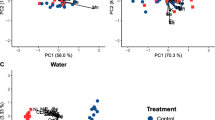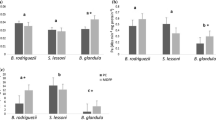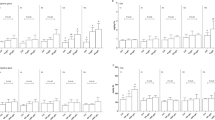Abstract
Toxic effects of continuous low dose application of the antifouling biocide chlorine on marine benthic organisms were monitored using transplanted green mussels (Perna viridis) and a suite of biomarkers. Caged mussels were deployed in chlorinated and non-chlorinated sections of the cooling system of an operating electric power plant. Biomarkers indicative of general stress, oxidative stress (superoxide dismutase and catalase), and DNA integrity, along with expression of stress proteins, were studied to assess the effects. Deterioration in condition index with corresponding increase in DNA strand breaks was indicative of chlorine stress. Superoxide dismutase enzyme did not show any particular trend, but catalase activity was high during the initial days of exposure at the chlorinated site; later, it became almost equal to that at the control site. Similarly, expressions of stress proteins (HSP60, HSP70, HSP22, GSTS1, and CYP4) showed bell-shaped pattern during the period of study. Positive correlation among the endpoints indicated the utility of the multimarker approach to monitor the effects of continuous low dose chlorination on mussels.






Similar content being viewed by others
References
Aebi H (1984) Catalase in vitro. Methods Enzymol 105:121–126
Almeida C, Pereira CG, Gomes T, Cardoso C, Bebianno MJ, Cravo A (2013) Genotoxicity in two bivalve species from a coastal lagoon in the south of Portugal. Mar Environ Res 89:29–38
Anderson D, Yu TW, Phillips BJ, Schmezer P (1994) The effect of various antioxidants and other modifying agents on oxygen-radical-generated DNA damage in human lymphocytes in the comet assay. Mutat Res Fundam Mol Mech Mutagen 307:261–271
Binelli A, Cogni D, Parolini M, Riva C, Provini A (2009) Cytotoxic and genotoxic effects of in vitro exposure to triclosan and trimethoprim on zebra mussel (Dreissena polymorpha) hemocytes. Comp Biochem Physiol C 150:50–56
Bolognesi C, Buschini A, Branchi E, Carboni P, Furlini M, Martino A, Monteverde M, Poli P, Rossi C (2004) Comet and micronucleus assays in zebra mussel cells for genotoxicity assessment of surface drinking water treated with three different disinfectants. Sci Total Environ 333:127–136
Bradford MM (1976) A rapid and sensitive method for the quantitation of microgram quantities of protein utilizing the principle of protein dye binding[J]. Anal Biochem 72:248–254
Cappello T, Maisano M, D'Agata A, Natalotto A, Mauceri A, Fasulo S (2013) Effects of environmental pollution in caged mussels (Mytilus galloprovincialis). Mar Environ Res 91:52–60
Chavan P, Kumar R, Kirubagaran R, Venugopalan VP (2016) Chlorination-induced genotoxicity in the mussel Perna viridis: assessment by single cell gel electrophoresis (comet) assay. Ecotoxicol Environ Saf 130:295–302
de los Ríos A, Juanes JA, Ortiz-Zarragoitia M, Alda ML, Barceló D, Cajaraville MP (2012) Assessment of the effects of a marine urban outfall discharge on caged mussels using chemical and biomarker analysis. Mar Pollut Bull 64:563–573
Dondero F, Dagnino A, Jonsson H, Caprì F, Gastaldi L, Viarengo A (2006) Assessing the occurrence of a stress syndrome in mussels (Mytilus edulis) using a combined biomarker/gene expression approach. Aquat Toxicol 78S:S13–S24
Elia AC, Anastasi V, Dörr AJM (2006) Hepatic antioxidant enzymes and total glutathione of Cyprinus carpio exposed to three disinfectants, chlorine dioxide, sodium hypochlorite and peracetic acid, for superficial water potabilization. Chemosphere 64:1633–1641
Frenzilli G, Bocchetti R, Pagliarecci M, Nigro M, Annarumma F, Scarcelli V, Fattorini D, Regoli F (2004) Time-course evaluation of ROS-mediated toxicity in mussels, Mytilus galloprovincialis, during a field translocation experiment. Mar Environ Res 58:609–613
Frenzilli G, Nigro M, Lyons BP (2009) The comet assay for the evaluation of genotoxic impact in aquatic environments. Mutat Res Rev Mutat Res 681:80–92
Giannopolitis CN, Ries SK (1977) Superoxide dismutases: occurrence in higher plants. Plant Physiol 59:309–314
Gichner T, Mukherjee A, Wagner ED, Plewa MJ (2005) Evaluation of the nuclear DNA diffusion assay to detect apoptosis and necrosis. Mutat Res Genet Toxicol Environ Mutagen 586:38–46
Gonzalez-Rey M, Mattos JJ, Piazza CE, Bainy ACD, Bebianno MJ (2014) Effects of active pharmaceutical ingredients mixtures in mussel Mytilus galloprovincialis. Aquat Toxicol 153:12–26
Gornati R, Papis E, Rimoldi S, Terova G, Saroglia M, Bernardini G (2004) Rearing density influences the expression of stress-related genes in sea bass (Dicentrarchus labrax, L.) Gene 341:111–118
Gutteridge JMC (1995) Lipid peroxidation and antioxidants as biomarkers of tissue damage. Clin Chem 41(12):1819–1828
Haque N, Kwon S (2017) Assessing the hydrogen peroxide effect along with sodium hypochlorite against marine blue mussels aimed at antifouling usage. Environ Eng Res 22(1):108–115
Jena KB, Verlecar XN, Chainy GBN (2009) Application of oxidative stress indices in natural populations of Perna viridis as biomarker of environmental pollution. Mar Pollut Bull 58:107–113
Krishnakumar PK, Asokan PK, Pillai VK (1990) Physiological and cellular responses to copper and mercury in the green mussel Perna viridis (Linnaeus). Aquat Toxicol 18:163–174
Lau PS, Wong HL (2003) Effect of size, tissue parts and location on six biochemical markers in the green-lipped mussel, Perna viridis. Mar Pollut Bull 46:1563–1572
Leung PTY, Ip JCH, Mak SST, Qiu JW, Lam PKS, Wong CKC, Chan LL, Leung KMY (2014) De novo transcriptome analysis of Perna viridis highlights tissue-specific patterns for environmental studies. BMC Genomics 15:1–14
Lewis BG (1984) Effects of continuous chlorination on mussels and validation of preliminary model. central electricity research laboratories, leatherhead, surrey. Report no TPRD/L/2594/N83, pp 1-15
Liu C, Gin KYH, Chang VWC (2014) Multi-biomarker responses in green mussels exposed to PFCs: effects at molecular, cellular, and physiological levels. Environ Sci Pollut Res 21:2785–2794
López-Galindo C, Vargas-Chacoff L, Nebot E, Casanueva JF, Rubio D, Mancera JM, Solé M (2010) Sublethal responses of the common mussel (Mytilus galloprovincialis) exposed to sodium hypochlorite and Mexel®432 used as antifoulants. Ecotoxicol Environ Saf 73:825–834
López-Galindo C, Ruiz-Jarabo I, Rubio D, Nebot E, Solé M, Mancera JM (2014) Temperature enhanced effects of chlorine exposure on the health status of the sentinel organism Mytilus galloprovincialis. Environ Sci Pollut Res 21:1680–1690
Manduzio H, Monsinjon T, Galap C, Leboulenger F, Rocher B (2004) Seasonal variations in antioxidant defences in blue mussels Mytilus edulis collected from a polluted area: major contributions in gills of an inducible isoform of Cu/Zn-superoxide dismutase and of glutathione-S-transferase. Aquat Toxicol 70:83–93
Masilamoni G, Jesudoss KS, Nandakumar K, Satapathy KK, Azariah J, Nair KVK (2002) Lethal and sub-lethal effects of chlorination on green mussel Perna viridis in the context of biofouling control in a power plant cooling water system. Mar Environ Res 53:65–76
Miklos M, Gajski G, Garaj-Vrhovac V (2009) Usage of the standard and modified comet assay in assessment of DNA damage in human lymphocytes after exposure to ionizing radiation. Radiol Oncol 43(2):97–107
Mitchelmore CL, Chipman JK (1998) DNA strand breakage in aquatic organisms and the potential value of the comet assay in environmental monitoring. Mutat Res Fundam Mol Mech Mutagen 399:135–147
Patetsini E, Dimitriadis VK, Kaloyianni M (2013) Biomarkers in marine mussels, Mytilus galloprovincialis, exposed to environmentally relevant levels of the pesticides, chlorpyrifos and penoxsulam. Aquat Toxicol 126:338–345
Rajagopal S, Nair KVK, Azariah J, Velde G, Jenner HA (1996) Chlorination and mussel control in the cooling conduits of a tropical coastal power station. Mar Environ Res 41(2):201–221
Rajagopal S, Velde G, Jenner HA (2002) Effects of low-level chlorination on zebra mussel, Dreissena polymorpha. Water Res 36:3029–3034
Rajagopal S, Venugopalan VP, Velde G, Jenner HA (2003) Tolerance of five species of tropical marine mussels to continuous chlorination. Mar Environ Res 55:277–291
Regoli F, Principato G (1995) Glutathione, glutathione-dependent and antioxidant enzymes in mussel, Mytilus galloprovincialis, exposed to metals in different field and laboratory conditions: implications for a proper use of biochemical biomarkers. Aquat Toxicol 31:143–164
Regoli F, Frenzilli G, Bocchetti R, Annarumma F, Scarcelli V, Fattorini D, Nigro M (2004) Time-course variations of oxyradical metabolism, DNA integrity and lysosomal stability in mussels, Mytilus galloprovincialis, during a field translocation experiment. Aquat Toxicol 68:167–178
Roméo M, Hoarau P, Garello G, Gnassia-Barelli M, Girard JP (2003) Mussel transplantation and biomarkers as useful tools for assessing water quality in the NW Mediterranean. Environ Pollut 122:369–378
Rossi F, Palombella S, Pirrone C, Mancini G, Bernardini G, Gornati R (2016) Evaluation of tissue morphology and gene expression as biomarkers of pollution in mussel Mytilus galloprovincialis caging experiment. Aquat Toxicol 181:57–66
Singh NP (2000) A simple method for accurate estimation of apoptotic cells. Exp Cell Res 256:328–337
Soldatov AA, Gostyukhina OL, Golovina IV (2007) Antioxidant enzyme complex of tissues of the bivalve Mytilus galloprovincialis lam. under normal and oxidative-stress conditions: a review. Appl Biochem Microbiol 43:556–562
Steinert SA (1996) Contribution of apoptosis to observed DNA damage in mussel cells. Mar Environ Res 42:253–259
Strickland JDH, Parsons TR (1972) A practical handbook of seawater analysis. Bulletin of the fisheries research, Board of Canada, pp. 263
U.S.Environmental Protection Agency (USEPA) (1978) Assessment of effects of chlorinated seawater from power plants on aquatic organism. Industrial Environmental Research Laboratory, Research Triangle Park EPA-600/7–78-221
Verlecar XN, Pereira N, Desai SR, Jena KB, Snigdha (2006) Marine pollution detection through biomarkers in marine bivalves. Curr Sci 91(9):1153–1157
Verlecar XN, Jena KB, Chainy GBN (2008) Seasonal variation of oxidative biomarkers in gills and digestive gland of green-lipped mussel Perna viridis from Arabian sea. Estuar Coast Shelf Sci 76:745–752
Viarengo A, Lowe D, Bolognesi C, Fabbri E, Koehler A (2007) The use of biomarkers in biomonitoring: a 2-tier approach assessing the level of pollutant-induced stress syndrome in sentinel organisms. Comp Biochem Physiol C 146:281–300
Vincent-Hubert F, Arini A, Gourlay-Francé C (2011) Early genotoxic effects in gill cells and haemocytes of Dreissena polymorpha exposed to cadmium, B[a]P and a combination of B[a]P and Cd. Mutat Res Genet Toxicol Environ Mutagen 723:26–35
Vlahogianni T, Dassenakis M, Scoullos MJ, Valavanidis A (2007) Integrated use of biomarkers (superoxide dismutase, catalase and lipid peroxidation) in mussels Mytilus galloprovincialis for assessing heavy metals pollution in coastal areas from the Saronikos Gulf of Greece. Mar Pollut Bull 54:1361–1371
Acknowledgements
The authors thank the authorities of Madras Atomic Power Station (MAPS), Kalpakkam, for providing the facilities and logistic support. The study was carried out as part of a collaborative project between ESSO-NIOT, Chennai, and BARC, Kalpakkam. The project was funded by ESSO-NIOT. The staff and students of BBPS are thanked for their assistance in field sampling. The authors thank the two unknown reviewers for their comments for improving the manuscript.
Author information
Authors and Affiliations
Corresponding author
Ethics declarations
Funding
The study was carried out using the funds provided by ESSO-NIOT.
Conflict of interest
The authors declare that they have no conflict of interest.
Informed consent
It is declared that the study involved no human participants.
Additional information
Responsible editor: Cinta Porte
Highlights
• Effects of chlorine on Perna viridis are analyzed using multiple biomarkers.
• Increased activity of antioxidant enzymes and expression of stress-related proteins suggest protective, followed by adaptive, response.
• The study is useful for devising a monitoring strategy for areas that receive chlorinated effluents.
Electronic supplementary material
Fig. S1
(DOCX 272 kb)
Rights and permissions
About this article
Cite this article
Chavan, P., Kumar, R., Joshi, H. et al. Multimarker study of the effects of antifouling biocide on benthic organisms: results using Perna viridis as candidate species. Environ Sci Pollut Res 25, 20407–20418 (2018). https://doi.org/10.1007/s11356-017-9607-z
Received:
Accepted:
Published:
Issue Date:
DOI: https://doi.org/10.1007/s11356-017-9607-z




